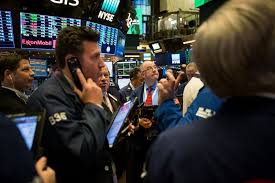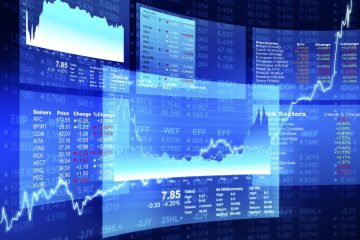Everything You Need to Know About Global Markets in 2018

And just like that, the year in which we learned to live with late night Twitter rants from a U.S. president, record-high stock prices and the bitcoin bubble comes to a close.
As we enter 2018, steadily rising assets and diminishing volatility have become the norm, global growth remains strong, and optimism prevails across asset classes. Yet now isn’t the time for complacency.
Between politics and popular trades losing luster, there are boundless risks to keep you on your toes for the next 12 months. Here are some of the most important market themes — both reassuring and unsettling — to get you started.
Cooling Credit Rally
Sure, cries of a junk bond Armageddon have proved premature, with both high-yield and investment-grade bonds handing investors returns for the year, but plenty of risks threaten the upside in 2018. The Federal Reserve is unwinding its balance sheet, the European Central Bank is slowing purchases and forecasts show inflation may finally rise.
Credit investors polled by Bank of America Merrill Lynch for a survey published in December named a bubble as the biggest risk to the asset class, followed by higher inflation and rising yields. Flows reflect some of that unease. Investors pulled money out of exchange-traded funds that track corporate credit for the first time in 14 months in December, data compiled by Bloomberg show.
Ageing Business Cycle
If the U.S. economy can keep chugging along through the first quarter of 2018, it will match the second-longest expansionary period in modern history, according to data compiled by the National Bureau of Economic Research and Bloomberg Intelligence.
That’s helping to lift global economies, spurring optimism across markets. The Citigroup economic surprise index of major economies hovers just under its highest level since 2010 after a slew of data surpassed analyst expectations.
In the year ahead, investors will have to assess the sustainability of the cycle amid risks of financial overheating and corporate America’s levered balance sheets.
Mind the Elections
Rising global growth, the Fed’s cautious approach to monetary tightening and a weaker dollar helped emerging-market currencies and stocks post their biggest returns in eight years in 2017. But it might not take much to knock that equilibrium, especially with Wall Street forecasting the biggest tightening of developed-world monetary policy in a decade.
Investors will also have to maneuver around elections in countries that make up more than 50 percent of a Bloomberg Barclays developing-nation local bond index. While votes in countries like Russia are predictable, tight contests are on the cards for fellow market heavyweights like Brazil and Mexico.
Euro Rally Lives
As the euro heads toward its best annual run against the dollar in 14 years, options markets that price probabilities on the world’s most traded currency pair point to the rally continuing in 2018. There’s a two-thirds probability that it appreciates as high as $ 1.229 by year end, while the odds that it rises to $ 1.256 are even.
‘Normal’ Swaps
One of the stranger distortions created by post-crisis regulation may be poised to end. Swap rates, what companies pay to exchange their fixed interest payments for floating ones, are on track to rise back above Treasury yields across all maturities for the first time since 2014.
Strategists predict Republicans’ plans to roll back post-crisis regulatory burdens will make holding Treasuries more attractive, thus pushing yields below swap rates again. The shift matters because swap rates serve as a benchmark for a variety of debt instruments purchased with borrowed funds, including mortgage-backed and auto-loan securities.
Volatility Return
In 2017, investors were caught off guard by the near-complete absence of volatility. In 2018 they could get a wakeup call from price fluctuations roaring back to life.
Over $ 2 trillion in strategies are effectively reliant on market stability to generate returns, according to October estimates from Artemis Capital’s Christopher Cole. That raises the risk of outsize losses across stock and bond markets around the world if volatility finally returns.
Fed Fresh Faces
Jerome Powell won’t be the only new kid in class at the U.S. central bank next year. The “Big Three” (chair, vice chair and New York Fed president) will be completely different after Janet Yellen’s stint in charge ends in February and the head of the New York Fed retires in the middle of the year.
They’ll have to weigh a tight labor market and sound economic data against muted consumer prices. How will they react if inflation roars back to life? And what if it remains stubbornly weak?
Yield Curve
The narrowing spread between short- and long-dated Treasuries continues to grab Wall Street’s attention. A completely flat — or inverted — curve has the potential to roil bond trades, challenge the Fed’s tightening path, and raises the risk of a downturn in the business cycle.
Six of 11 analysts surveyed by Bloomberg in early December said the Treasury yield curve will invert at least briefly within the next 24 months, with four projecting it in 2018.
Don’t Forget China
Two of the more remarkable moves in 2017 were soaring U.S. stocks and tumbling Chinese government bonds, according to a global analysis of historical price patterns that veer from the norm, known as standard deviations. While the S&P 500’s valuation is endlessly analyzed, the outlook for the world’s largest emerging debt market is far less understood.
Chinese bonds will come under pressure again in the first half of 2018 as the central bank tightens monetary policy and the government toughens financial regulations, according to Becky Liu, head of China macro strategy at Standard Chartered Plc. The rise in yields will attract domestic and foreign investors in the second half, she said.
Crypto Craze
How long can bitcoin’s parabolic increase last? It depends who you ask. Hedge fund manager Michael Novogratz thinks it will go all the way to $ 40,000 by the end of the first quarter. Bulls say the recent creation of futures will broaden crypto ownership because derivatives are the first step toward ETFs and other more liquid instruments.
The skeptics, however, points to a possible pin-prick by regulators. Cryptocurrencies “could be stopped in their tracks” if authorities began applying anti-money laundering laws, said Marc Ostwald, global strategist at ADM Investor Services International in London.


